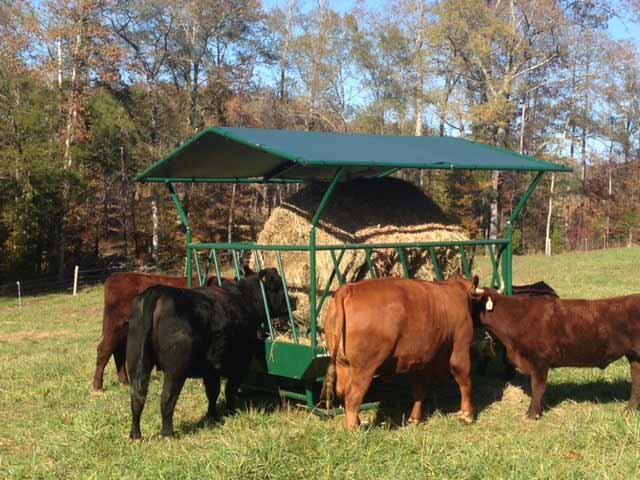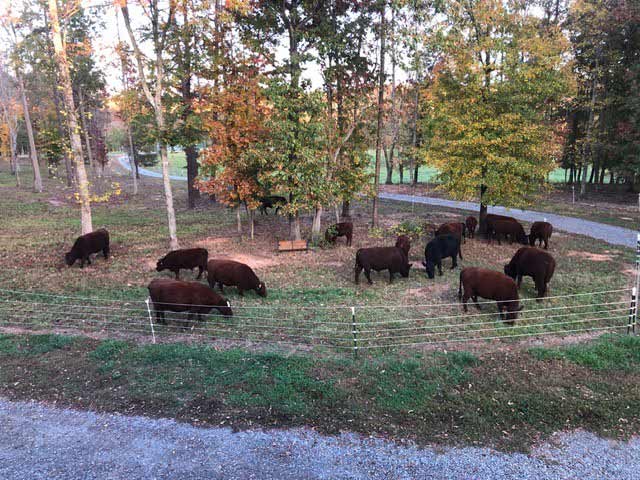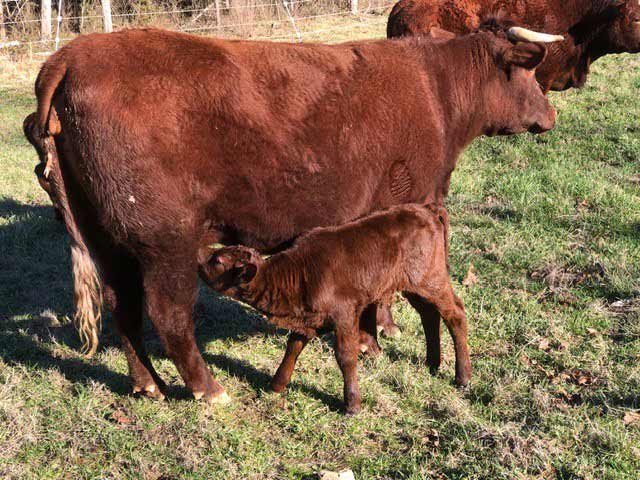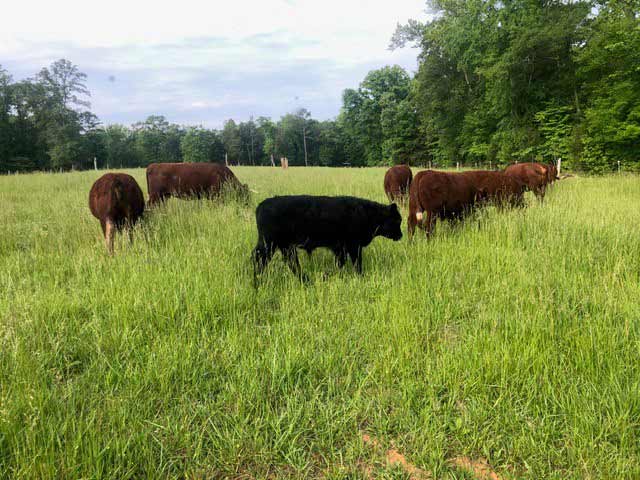The Difference between Gourmet Grass-Fed and Regular Grass-Fed Beef
Edgemoor, SC– Consumers need to know the difference between true Gourmet Grass-Fed Beef and regular grass-fed beef. There seems to be a significant amount of confusion in the marketplace so lets clear that up right now.
Let’s begin at birth. Most cows that are destined for beef consumption come from what is known as Cow/Calf operations. These are farms where Momma cows are bred to produce a calf. The male calves are castrated when they are only a month or two old as the earlier this is done the easier it is on the animal and the quicker they heal.
Castration is done to eliminate testosterone so the animal is more tender, marbles (more fat) better and is docile and easier to handle. Prior to castration the males are “bull calves” and afterward they are “steers”. The females (heifers) may be grown for beef as well. But depending on market conditions they could be more valuable as breeding animals.
Young calves spend their first six to eight months with their mothers. They nurse on Momma and begin eating what she eats; grass and hay typically. When the calves are weaned (taken off Momma) it’s pretty stressful for them and they cry and bellow for four days and nights on and off. After the fourth day they settle down and start grazing grass.
Stocker Calves
Weaned calves are typically sold as “stockers” to farms where the animals are grazed on grass until they’re a year or so old. Then they are sold to feed lots, typically located in the mid-west to fatten on grain. Now, this is really important so take careful note! Beef can legally be marketed as grass-fed if the animal has eaten grass for two thirds (2/3) of its life. The last one third (1/3) they can be fed nothing but grain and STILL be marketed as grass-fed.
Now ain’t that something!
Studies show that after an animal has eaten grain for 60 days straight they lose much of the healthy benefits of eating grass. The grain feeding does indeed fatten up the animals quickly and often they are harvested at only 18 months of age. So the “grass-fed” beef sold in supermarkets is generally fed grain the last third of their lives completely eliminating the healthy grass-fed benefits.
We have a wide variety of gourmet grass-fed beef cuts including steaks roasts short ribs and amazing ground beef! All backed by our Iron Clad 100 percent money back guarantee!
Puddle Moon Farm
Our Current Beef Price List
Grass-Fed Beef Pricing Per Pound
Filet Mignon $34.00
NY Strip Steak $25.00
Rib Eye Steak $28.00
Sirloin Steak $18.00
Chuck Roast $9.50
Bottom/Rump Roast $9.00
Sirloin Tip Roast $10.00
Brisket $12.00
Ground Beef 80/20 $11.00
Cube Steak $9.00
Beef For Stew $8.00
Short Ribs $12.50
Beef Shank (Osso Bucco) $10.00
Soup Bones $4.50
Liver $6.50
Pricing is subject to change without notice.
We have a wide assortment of delicious grass-fed beef cuts available in our freezer now so call DeAnn at 803-487-7106 while we have a good supply to choose from.
Grass-Fed and Grass-Finished
But we do things differently at Puddle Moon Farm. Our grass-fed beef is also grass-finished. What this means is our animals eat grass from start to finish so all the good health benefits of grass-fed beef are retained.
This means our animals grow more slowly compared to grain finished animals. This takes much longer for us to raise an animal before slaughter but we believe the extra time pays off in quality. So that’s the first component of Gourmet Grass-Fed Beef; finishing on good healthy grass.
The second component is genetics. You see, all “cows” are not created equal. We learned this ourselves before we started Puddle Moon Farm. In fact, it’s one of the reasons we decided to start the farm. For several years we bought “grass-fed beef” because of the obvious health benefits. But we soon discovered there was a significant difference in taste, tenderness and marbling even when we bought meat from the same farm.
Our research suggested genetics makes a big difference in the quality and flavor of grass-fed beef.


Genetics makes all the difference
Some grass-fed beef farms buy young animals at the local sale barn. They then put them on their pastures and graze them to slaughter weight. They may even finish them on grass. But their attitude is that a cow is a cow and it makes no difference in meat quality.
We strongly disagree because studies clearly show that certain breeds consistently rate highest for taste, tenderness and marbling. And that’s why we specifically chose Red Devon and South Pol animals for our grass-fed beef operation. These two breeds consistently rate highest in taste tests for grass-fed and finished beef.
It makes it harder on us because we will NOT throw any old cow into our herd of gourmet beef cows. They have to be at least 75% or more Red Devon or South Pol in order to make the cut so to speak. This raises our costs but we believe the added flavor, tenderness and quality are worth the effort. We will not compromise when it comes to genetics.



Our animals are “slow growers” because it takes time to fatten animals on grass alone. Typically our animals are not harvested until they are two and a half to three years old.
The Benefits of Rotation
Grass-fed beef cows are raised in grass pastures. Most farmers place their animals in a pasture and leave them there until the grass is eaten up and then they’re moved to a new fresh pasture and the cycle repeats.
We do things differently at Puddle Moon Farm. We move or “rotate” our cows to fresh grass daily. Rotation is more time consuming but it promotes healthy “competitive grazing”. The cows eat more grass because the supply is limited. By keeping them together they “compete” for the available grass.
And since the supply is limited they eat ALL the grass available, including some of the less desirable grass that has excellent health benefits like Lespedeza. They also eat more because the new, fresh strip of grass hasn’t been pooped and peed on by the cows. So every day they have access to fresh grass and they get visibly excited when we move them to their new grazing area daily.
Again, this increases our costs because it requires an investment in additional temporary fence posts and wire. And we have to move the fence every day to accommodate the new grazing area taking time and effort.
Another benefit of rotating the animals is it spreads out their natural fertilizer, manure. Unmanaged cows will hang out in the same area (they are herd animals after all) building up excessive piles of manure in one place. Rotating them helps mitigate this issue and helps build high quality soil rich in healthy minerals.
Rotating the animals daily is more labor intensive, time consuming and costly but we believe the extra effort pays off in our high quality, gourmet grass-fed beef.
Speaking of Water. . .
We believe clean, cool water is vital to maintaining a healthy herd of beef cattle. So we’ve installed underground water lines that are connected to our well. Our beef cows drink the same water we drink in our home.
This may sound like a small thing but if you talk to any veterinarian they’ll tell you how important clean water is to animal health. You see, some farmers let their cows drink from ponds or streams that all too often have been pooped and peed in.
The animals may not show any ill effects, at least right away. But we don’t want to take that chance so we have invested in a quality, clean water system. Again, all this adds to our costs but quality is not cheap!
No High Power Lines
You may think this is crazy but we had Duke Energy reroute the power lines that went through our primary pasture when we bought the property in 2012. Duke quoted us a price of $17,000 to do the reroute! Fortunately, they worked with us to dramatically lower the costs when we offered to clear the brush and timber from the road shoulder for the reroute.
We may be crazy but our research suggested close proximity to high power electric lines could emit unhealthy electromagnetic frequencies (EMF) that could have a negative impact on our cows. No, you may not see any visible harm but there are a variety of studies that suggest prolonged EMF exposure can potentially have a detrimental impact on animals (and humans) health.
Of course, not all farmers have concerns about EMF exposure and that’s fine. We just believe taking this extra step can only add to the quality of our grass-fed beef.
No Rushing Mother Nature
As I mentioned earlier cows fed in feed lots can legally be called “grass-fed” provided they eat grass for a minimum of two thirds (2/3) of their life. Feeding them grain artificially fattens them quickly so they can be harvested fast, often in just 18 months, making more money for the producer.
Our animals are “slow growers” because it takes time to fatten animals on grass alone. Typically our animals are not harvested until they are two and a half to three years old. Again, this takes more time but it allows our animals to fatten naturally. Our Red Devon and South Pol animals are fully grown when they reach about 1,000 pounds.
That sounds like a lot but other breeds like Black Angus can reach 1,400 pounds or more fully grown due to their larger frames. So we get less meat per animal relative to grain fed cows. But again, the genetics of our Red Devon’s and South Pol’s mean a much tastier, tender, well marbled cut of beef. Again, it takes more time and patience to raise beef cows like this but we believe the quality is worth it.
To Summarize
I hope you’ve found this information helpful. To summarize there are six reasons we call our Grass-Fed Beef Gourmet.
- Our animals are not only grass-fed but also grass-finished.
- We only use animals that are at least 75% Red Devon and or South Pol genetics.
- Our animals are rotated to fresh grass daily.
- Our animals enjoy access to clean fresh water.
- No exposure to High Power Electric lines.
- Slow growing animals; we don’t try to rush mother nature.
We believe our grass-fed, grass-finished gourmet beef is so superior that we guarantee it. If you buy our meat and aren’t absolutely delighted with a particular cut, we’ll replace it free of charge or refund your purchase price in full!
We look forward to serving you and your family the highest quality grass-fed beef available!

Contact Us to Order Our Premium Meats
Join us in celebrating the true taste of nature's bounty and discover why our meats are a favorite for families who value both flavor and sustainability.
Sales are by appointment Only.
Call DeAnn at 803-487-7106 or email deann.harris@yahoo.com to schedule your visit.
We Gladly accept Cash and Personal Checks.

